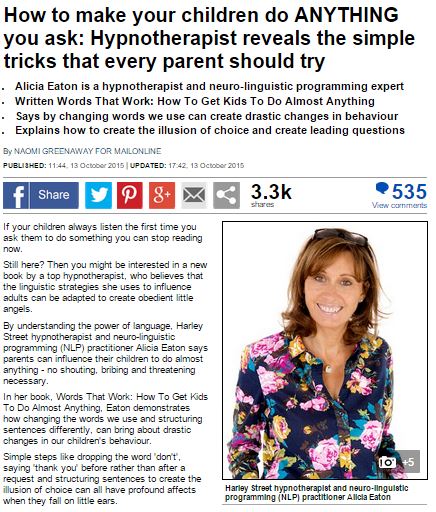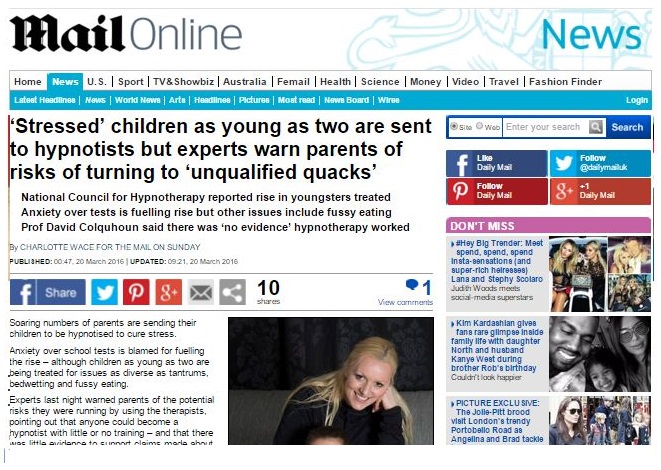A new book aims to help parents talk to their children in a different way and help them to get the results they want from any conversation.
As a parent do you struggle with the way that you ask your children to do tasks? Do they refuse or answer back? What if there was a way that you could influence them without them even realising?
The Daily Mail reports on a new book by Alice Eaton who is a Hypnotherapist and NLP practitioner. In it she outlines her tips for helping you talk to your kids and being a more effective parent.
There’s another book that could help you too
It’s not the first book on this subject of course and many people have pointed out that you can get pretty much the same advice in the book “Between Parent and Teenager” by Haim Ganot. That was published in 1985 and is still available on Amazon. Just click on the title and you can see it for yourself.
Words That Work: How To Get Kids To Do Almost Anything
In her book, Words That Work: How To Get Kids To Do Almost Anything, Alice Eaton demonstrates how changing the words we use and structuring sentences differently, can bring about drastic changes in our children's behaviour.
Simple steps like dropping the word 'don't', saying 'thank you' before rather than after a request and structuring sentences to create the illusion of choice can all have profound affects when they fall on little ears. 
Here are her top ten tips for talking to your child to get the result that you want...
- Always say what you DO want your child to do, and not what you DON'T
'Too many of us get stuck in a cycle of negative talk which quickly turns into nagging,' says Eaton.
Phrases like, 'Don't leave your room in a mess', 'Do you have to leave your shoes lying around?' or, 'How many times have I told you not to push your sister around?' are counter-productive.
'We use negative talk and then we're surprised when our children don't do what we want them to,' she says.
But, says Eaton, 'they're not mind-readers' and suggests turning the phrases around into a positive to get more effective results.
Phrases like 'Let's leave the room tidy and put all the Lego away'; 'shoes belong in the cupboard under the stairs' or 'let's get our skates on and see if we can be early for school today!' are more likely to get results.
2. Create the illusion of choice
If saying, 'Hurry up and get dressed for school' doesn't spur your child on, then Eaton suggests: 'Nudge your child in the right direction by offering the illusion of choice.'
Pose questions such as, 'Which T-shirt will you be wearing this morning, the blue one or the red?' or, 'Which will you put on first, the trousers or the T-shirt?'
'This pre-supposes that the child has agreed to get dressed and overcomes the impasse,' she explains and says that creating that element of choice can work wonders in many scenarios.
If there is reluctance to doing homework, Eaton suggests giving the child a choice of when to do the work, with a question such as, 'Do you want to work on your school project today or tomorrow?'.
Or if your child is being fussy at mealtimes you could ask, 'Would you like to taste the broccoli or the carrots first?'.
If they never let go of the phone Eaton suggests asking, 'Will you be leaving your phone on the hallway table or upstairs in the bedroom when it’s time for dinner?'.
3. Talk as if it's a given that your child will do what you ask
'The word "when" is often referred to as the most hypnotic word in the English language. It gently implies that something will be done in the initial instance,' says Eaton.
Give your child the subtle message that the task ahead is a fait accompli by clever use of the 'when' word.
Eaton suggests phrases such as: 'When you've tidied your room, we'll have some lunch', 'When you've finished your maths homework, we'll be able to go out to the park' or 'When you've put your uniform on, we can go downstairs for breakfast'.
As you get better at this technique, try adding two presuppositions into the sentence.
'Car sales people often use this pattern,' says Eaton. 'They'll say, "When we've been out for a test drive, we'll come back and you can choose a colour scheme for the interior."
'You may not have even been asked whether you would like to take a test drive. You're being gently pushed along the sales process.
According to Eaton the technique can be just as easily applied to influencing our children.
At homework time, for example, try oiling the process by using two presuppositions. For example say, 'When you've finished your comprehension, you'll notice how easy it is to learn those spellings'.
4. Create a linguistic connection between you and your child
According to Eaton, creating a link with your child in the language you use can be a powerful tool in increasing their inclination to listen.
Eaton suggests putting yourself in your child's place and vice versa with phrases such as 'I, like you, realise you have lots of choices in front of you' or 'You, like me, realise how much easier it is to do homework with a tidy desk'.
'The "like" pattern is useful for slipping into conversations and can boost your child's self-esteem and establish rapport,' explains Eaton.
'It's particularly useful if you feel your relationship with your child has become difficult.'
5. Say 'thank you' before, rather than after
'We're used to thanking people after they've done something for us, but what about thanking before it's been done?' asks Eaton.
'This often works well because children naturally want to please people, especially their parents.'
So next time you ask your child to wash their hands, come to the table or switch off the TV, quickly follow it up with a 'thank you'.
'It's a great way to wrong-foot a child who was going to ignore your request,' explains Eaton. 'Once they've been thanked, they feel obligated to perform the task.'
6. Always give your reasoning
Often we expect children to jump to it without really understanding the reason behind what we are asking of them.
'By explaining why we're asking for something, our request is more likely to be granted,' says Eaton, who suggest simply adding a 'because' to every request.
If the music is blaring try saying: 'Let's turn the volume down and start being a bit quieter because we need to decide what we're going to do next and it will be easier to think of good ideas'.
If you need help with the shopping, try: 'Can you help me carry the shopping from the car because there are just too many bags for me to do them in one trip.'
7. Front-load your sentences
'Front-loading your sentences with phrases such as 'think about it' and 'listen' sends a powerful suggestion to your child to do just that,' says Eaton.
Try creating motivation by saying: 'Think about it. How good will it feel once you've finished your homework?'
Or add weight to your request using the 'listen' word, for example: 'Listen, here's what I think needs to be done next' or 'Listen, we need to quickly put our coats on or we'll miss the bus'.
8. Put a positive spin on moaning
Some children get stuck in the habit of complaining, but according to Eaton: 'You can help your child get in the habit of looking for solutions by reflecting or bouncing the statement back to them with a positive spin.'
If, for example, your child complains 'I'm too hot!', Eaton suggests bouncing back with something positive. She suggests: 'Ah, you'd like to feel cooler. What would make you feel better – opening a window or removing your jacket?'
If they come out with something negative like, 'I hate sharing a bedroom', try spin it into a positive.
Eaton suggests responding with: 'What is it about having your own space that appeals to you?'
'These responses result in less moaning, less complaining and are more solution focused,' she says.
9. Use leading questions
'Using leading questions is a useful language pattern that can help to take your child from a problem to a desired solution,' explains Eaton.
Eaton suggests the following sentences as examples of how to put a positive spin on a problem and at the same time help your children feel part of the solution.
'So, you've been feeling worried about your exams – to make yourself aware that you need to do something more about them?'
'So, you're talking to me about this now - in order to start making some changes?'
'So, you're telling me about how much you hated this year's maths teacher – so you can begin to look forward to the new one you'll be having when you go back to school?'
10. Help your child stop using the 'can't' word
Eaton believes the word 'can't' is used too often in conversations and shuts out the possibility of achievement.
'To get your child out of this habit, highlight that things can and do change,' says Eaton.
'Your child is changing all the time, which means not being able to do something is merely transient,' she adds.
When your child says, 'I can't do maths!' Eaton suggests turning it around into, 'Ah, you just haven't yet found a way to do that particular exercise yet'.
Or you could say: 'You completed the multiplication exercises and you just haven't yet found a way to do fractions.'
'The idea is to switch focus to talk about what your child can do rather than what they can't,' Eaton explains.
Help shift your child's mind-set to a more open one of possibilities and make your life - and theirs - a little easier.
It’s not only a great thing to think about the way you speak and talk to your children when you need to get them to do something, but also to be aware of how that helps them in the future with the way that they talk to people as well.
You can read all about my working methods and how Hypnotherapy sessions for children can help them here: Hypnotherapy for Children.

